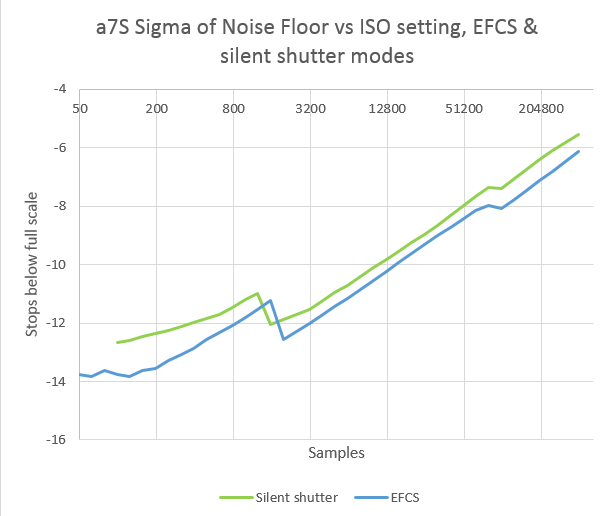I received a request to compare the read noise versus ISO setting of the Sony a7S in silent shutter mode to that of single shot electronic first curtain shutter (EFCS) mode. I already had the data (look here ), so all I had to do was put both curves on the same graph:
Mostly as expected, but the lower-ISO kink in the two curves occurs in different places. That’s strange. I went back and checked the raw files. No error there.
It looks like there’s a difference in the way the sensor operates in the two modes: going from low conversion gain to high conversion gain on the 1600 to 2000 ISO change in EFCS and on the 1250 to 1600 ISO change in silent shutter mode .

Thanks! Ur articles are excellent and very technical. I learn a lot from you!
I have a question. I have both an A7 and A7s. I found that A7s consistently gives a more ‘medium frame look’ at all ISO. It’s not placebo. Any possible reason for this?
I don’t know how to define, consistently recognize, or test for the MF look. You say it’s not a placebo effect. Have you tried a double-blind test?
If what you’re seeing is somehow the effect of the big pixels, look at some Nikon D3 or D3s photos and see if you see the same quality.
I’d be interested in your impressions.
Jim
Jim, could you please add your “conclusions” or “final thoughts” so people with not technical knowledge can understand 🙂
I’m not sure about the graph but it it seems the camera in silent mode has more noise ?
Luis, my blog is aimed at people who either have some technical knowledge or want to learn. However, I am always happy to answer questions and attempt to explain things in words of one syllable.
You are right about the a7S noise in silent mode, and that’s what the graph says, too.
Thanks for reading,
Jim
Thanks Jim !
A7S made pictures with covered lens. The “silent mode” you can see thousands of white points. If I use a conventional shutter, white dots disappear.
Bummer. I don’t see that with my a7S.
Interesting comment Pasu. I love the output of my D700 which shares the D3 sensor, and always found D800 and other cameras had a different color output – more ‘digital’ if you will. UNTIL I got the A7s whose files I see have that same organic warmth that I felt from the D3 / D3s sensors.. I thought I was imagining this. Never realised it could simply be because of those giant pixels!